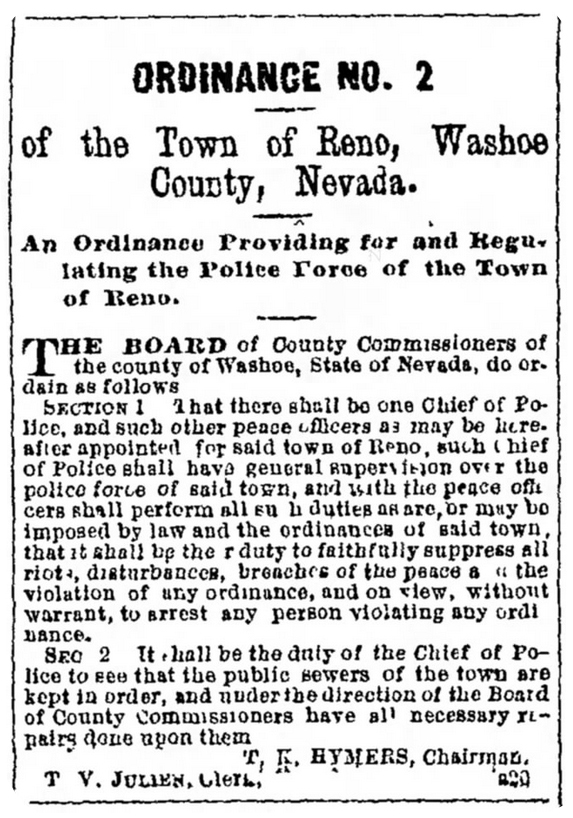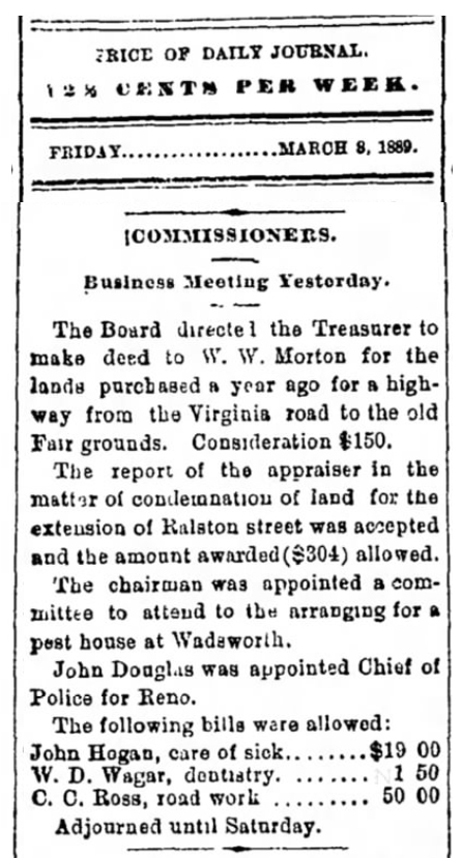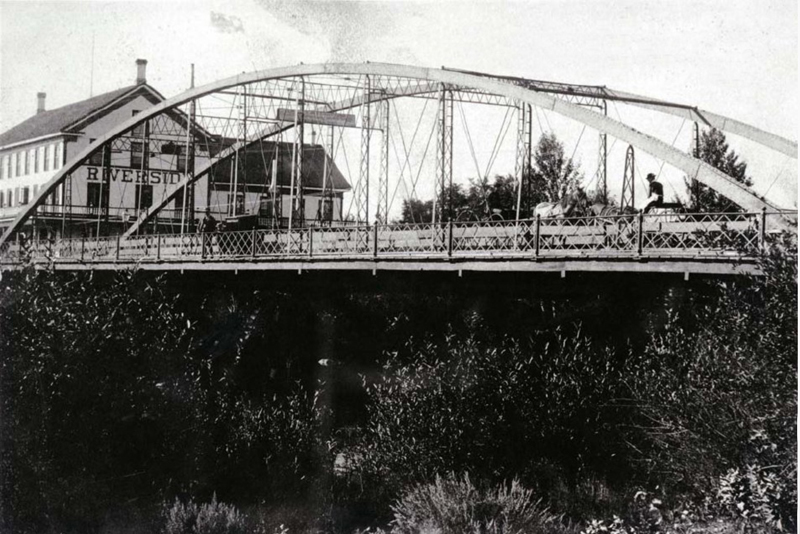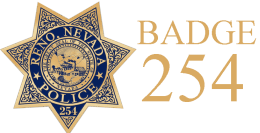
The Creation of Reno's First Police Department
In 1889 the first Reno Police Department was created as part of the re-incorporation of Reno.
While Reno had been incorporated as a Town in 1879, a police department was never created prior to 1889, and law enforcement was left to the Sheriff and the elected Constable and his Deputy Constables.
John Douglas, Chief of Police

On Friday, March 8, 1889, John Douglas was appointed by the Washoe County Commission as the first Chief of Police for what was then the incorporated Town of Reno Nevada.
*** LINKS TO ADDITIONAL READING ***
John Douglas, Chief of Police 1889 - 1893

The iron bridge which crossed the Truckee River at Virginia Street was the path to the Washoe County jail from downtown Reno. The jail was just on the other side of the Riverside Hotel. On September 19, 1891, a lynch mob, angry over the shooting of Reno Police Officer Richard Nash, removed the shooter, Louis Ortiz, from the county jail and hung him from the Virginia Street bridge which was referred to at the time as "The Iron Bridge".
First Police Chief in Reno is a Forgotten Man
by Jim Gibbs
While most that write of the History of the Reno Police begin their accounting in 1903 with the incorporation of the current City of Reno, fact is Reno had a police department much earlier. On Friday, March 8, 1889, John Douglas was appointed by the Washoe County Commission as the first Chief of Police for what was then the incorporated Town of Reno Nevada. He would hold the position for about four years.
While he was assisted by several officers with titles as “Watchman” or just paid for “watching” as were Richard Nash and D. Dicky. There is evidence that Harry Brown was also employed as a police officer in 1889. Regardless, Chief Douglas was the primary Reno law enforcement officer. John Douglas was not only Reno's chief of police, he was also required to supervise the connecting and the flushing of sewers, and to direct and supervise the work of extension and repairs upon the public streets and alleys. The non-law enforcement duties may have been the reason John Douglas was targeted to be chief of Police. In 1884 he was a candidate for the position of “Road Supervisor in which he campaigned his experience of working prison labor building and repairing roads. However, an article about working prisoners in 1888 quoted the “Roadmaster” John Douglas as saying he would not work prisoners and there was no law compelling him to work them. As chief of police one year later, working prisoners surely seemed like a good plan.
Of course along with the watchmen, he was also tasked with the duties of seeing that all ordinances were enforced and properly observed. The officers also responded to disturbances such as the one in September 1991 at the Grand Central Hotel in which Officer Nash was shot by Louis Ortiz. Ortiz would pay with his life for shooting Officer Nash when a lynch mob took him from the county jail and hung him from the “Iron Bridge” crossing the Truckee River at Virginia Street
Reno was an undefined sort of community during this time. It was first and foremost the county seat. Secondly, it was a major railroad connection connecting the Southern Pacific Railroad and others such as the V&T Railroad. Reno wasn't much to look at, despite the appalling pride of its citizens. When John Douglas posted his $100 bond and got paid $25 a month for battling with the people of Reno to obey new ordinances. They really didn't care to be run by the county commissioners. While not much is known about John Douglas, some believe he must have been a tough individual considering the resistance he surely encountered.
In the very beginning the commissioners ordered Douglas to remove a threat to the "cattle bridge" crossing the Truckee River. Actually, just hours before his appointment as chief, the Washoe County Commission had John Douglas remove the Electric Light Company's dam from the bridge's proximity. Whether Douglas did the job singlehanded was never recorded, but the dam apparently went downstream, probably to the anguished howls of the Light Company's officials.
County Commission records reveal that Douglas spent a lot of time with the sewers during his first five months of office. He submitted several bills for sewer work one being for $348.50 which for the time was a sizable amount of money. One has to assume the payment was for the work of others and the repayment for equipment and material.
Things picked up in the law enforcement business however, and Douglas never again submitted a bill of that size for his labors as sanitary engineer. It was also obvious from public service announcements in the paper that Chief Douglas took on the responsibility of notifying the citizens of new ordnances in the Town of Reno that would be enforced.
In 1890 he cited Section 13 of a town ordinance which made it unlawful for any person, in any of the streets or highways within the town limits to play baseball, cricket, football or any other game having a tendency to interrupt the free and safe use of d said streets or highways.
He also announced the sale of impounded stock. Most specifically a bay mare and a small sorrel horse both of which were at the "pound".
in 1991 Douglas announced that all parties buying dog tags would be required to put them on their dog's collars where they can be seen by the pound master.
He also cautioned that all persons be notified that the streets and alleys are not to be used as a dumping ground for filth and rubbish. And that the law regarding the dumping would be enforced.
In short order came other laws. By 1893 Douglas did everything from hauling dead animals "one-half mile outside the town limits" to chasing Reno's kids who persisted in playing ball or indulging in the "throwing of missiles" in streets, alleys or other public places.
THE SIDEWALK CHECK
Complying with Town Ordinance No. 9, the busy Douglas measured the width of sidewalks and called on those who had built their walks wider or narrower than the city demanded. Apparently, the sidewalk ordinance sought a standard wooden pathway and placed it upon the chief of police to see that standard width was obeyed.
Douglas was also traffic officer of a sort. He can be pictured strolling up to a "dray, hack, carriage, express or accommodation wagon" obviously parked for some time, and demanding of the driver whether permission for the sidewalk stabling had been given by the proprietor of the nearest business house.
When R. H. Lindsay and Pierce Evans appeared before the commissioners in September of 1889 and demanded that something be done about the way the Nevada California Railroad was obstructing Lake St., it was Douglas who was sent out to "remove the obstruction." Just what the railroad had set up north of the Central Pacific tracks was never defined, but Douglas got rid of it. He probably received a few words of criticism from the railroad's personnel at the time, a cop's life being what it is.
Near the end of his police career, Douglas was required to go about tearing down fences, especially those made of barbed wire. Anybody who put up a fence or maintained one after June 20, 1892, was considered to be harboring a nuisance. Fine for such a nuisance was $50, and an alternate penalty was 25 days in jail. Why the commissioners insisted that people yank down their fences and be neighborly is something to puzzle. It is surprising to note that the fencing laws stayed on the books until Reno became a city in 1905.
ELM STREET OPENED
Now and then Douglas would sandwich in some sewer or street work. In the early months of 1893, he was required to open Elm Street. from Sierra to Ralston, which apparently was done without much difficulty. A remaining section of Elm Street from North Arlington to Ralston is still open today which may be considered the one known lasting monument to the otherwise lost-in-time John Douglas.
When the fire department shakeup occurred in early 1892, John Douglas was again called upon. He was appointed assistant chief of the brigades, and accepted the position along with the rest of his labors. The fire chief's assistant didn't get paid anything either. It is interesting to note that when Reno would incorporate in 1903 and appoint Charles Leeper as their Chief of Police, he was also given the duty as Fire Chief.
Somewhere around June of 1893, H. P. Brown took over as chief of police. The very last mention of Douglas was in the commissioner's minutes of August, 1893, where he was allotted $6 for "water." Whether he had gone into the sewer, fire department or utilities business was never explained.

SHARE THIS PAGE!